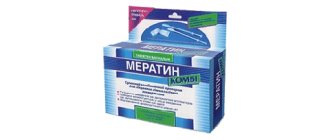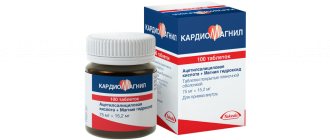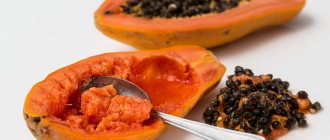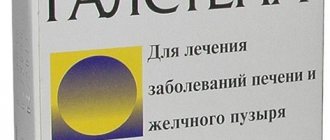Release form and composition
- coated tablets: biconvex, round, sugar coated, pink (20 pcs. in blisters, 1 blister in a cardboard box);
- solution for injection: colorless transparent liquid for parenteral administration (2 ml in dark glass ampoules, 6 ampoules in a cardboard box);
- syrup: liquid of sweet caramel taste, orange color (60 ml in dark glass bottles complete with a measuring pipette, 1 set in a cardboard box).
1 tablet contains:
- active ingredient: prifinium bromide – 30 mg;
- auxiliary components: starch, lactose, povidone, magnesium stearate, colloidal silicon dioxide, croscarmellose sodium, gelatin, talc, titanium dioxide, paraffin paraffin, carnauba wax, sucrose, FD&C red dye No. 3.
1 ml of solution for injection contains:
- active ingredient: prifinium bromide – 7.5 mg;
- auxiliary components: sodium chloride, hydrochloric acid, water for injection.
1 ml of syrup contains:
- active ingredient: prifinium bromide – 1.5 mg;
- auxiliary components: glycerin, propylene glycol, sodium benzoate, sucrose, liquid sorbitol, sodium citrate, sodium saccharin, monoammonium glycyrrhizinate, liquid caramel flavor, dyes: FD&C yellow No. 6 and FD&C red No. 40, purified water.
Pharmacological properties
Pharmacodynamics.
Riabal selectively blocks peripheral m-cholinergic receptors of the mucous membrane of the digestive tract, bile and urinary tract and uterus. Riabal does not penetrate the geb. By selectively blocking M-cholinergic receptors, Riabal makes them insensitive to acetylcholine, which is formed at the endings of postganglionic parasympathetic nerves. The consequence of this is a decrease in the tone of the smooth muscles of the esophagus, intestines, gall bladder, bile ducts, urinary tract and uterus, as well as a decrease in the secretion of hydrochloric acid, pepsin, and exocrine activity of the pancreas. With prolonged use, Riabal does not have a negative effect on the function of the liver, kidneys, or hematopoietic tissue.
Pharmacokinetics. The drug is poorly absorbed from the gastrointestinal tract. Blood plasma clearance and renal clearance are 12.5 and 5.80 ml/min/kg body weight, respectively. T½ is 2.13 hours. It is excreted in feces and urine.
Indications for use
- pain syndrome associated with increased peristalsis and spasms of the gastrointestinal tract (GIT), caused by acute inflammation of the gastric mucosa, exacerbation of chronic gastritis, gastric and duodenal ulcers, enterocolitis, irritable bowel syndrome;
- pain syndrome associated with spasms of the smooth muscles of the gallbladder and biliary dyskinesia caused by calculous cholecystitis, inflammation of the pancreas, pancreatitis;
- pain syndrome associated with spasm of the genitourinary tract caused by algodismenorrhea, urolithiasis, cystitis (inflammation of the bladder);
- pain in the epigastric region due to impaired function of the large intestine, accompanied by flatulence and symptoms of intestinal obstruction;
- vomiting, bloating, intestinal colic (spasms of smooth muscles of the gastrointestinal tract) in newborns and infants;
- organic gastrointestinal diseases, vomiting due to acute gastroenteritis, hyperthermia, intracranial hypertension, radiation therapy;
- instrumental and radiological examinations of the gastrointestinal tract (as a means of preliminary preparation before procedures).
Side effects
When using Riabal drugs, a number of adverse reactions may occur, among which patients are most often concerned about:
- dyspeptic disorders such as constipation, dry mouth and nausea;
- skin forms of allergies in the form of rash and itching, Quincke's edema and urticaria;
- changes in the functions of the cardiovascular system in the form of increased blood pressure and heart rate;
- headache;
- weakness and fatigue;
- urinary retention.
Contraindications
Contraindications to the use of Riabal are in one way or another related to its ability to influence the functioning of other organs and systems; it cannot be used for the following diseases of the heart and blood vessels:
- ciliated artymia;
- sinus tachycardia;
- IHD and CHF;
- mitral valve stenosis;
- hypertonic disease;
- bleeding in the acute stage, including gastrointestinal;
- hyperthermia.
It is not recommended to use the product in the presence of stones in the gallbladder, and the diameter of the formations exceeds the diameter of the ducts, in case of acute urinary retention, in the presence of megacolons and intestinal atony.
Contraindications to the use of the drug are also glaucoma, prostate adenoma and allergies to the components of the drug.
With great caution and only in case of vital indications, Riabal is prescribed for liver failure, achylia, reflux esophagitis, autonomic neuropathy, nonspecific ulcerative colitis and COPD.
Pregnancy
Pregnancy is not a contraindication to the use of Riabal, therefore women carrying a child can use the drug after prior consultation with their doctor.
During lactation, the use of the drug should be limited to cases where the benefit to the mother many times exceeds the potential risk to the nursing child.
Directions for use and dosage
Film-coated tablets Riabal tablets are taken orally.
Recommended dosage regimen depending on the patient’s age:
- children 6-12 years old – 1 pc. (30 mg) 2-3 times a day;
- children over 12 years old and adults – 1-2 pcs. (30-60 mg) 3 times a day.
If necessary (to relieve severe acute pain), adults are allowed to take 3 tablets (90 mg) at a time.
Solution for injection Solution for injection Riabal is administered subcutaneously (SC), intravenously (IV) or intramuscularly (IM), depending on the indications.
Recommended average doses for adults:
- single dose – 15-30 mg (1-2 ampoules), maximum single dose – 90 mg (6 ampoules);
- daily – 45-90 mg (3-6 ampoules), maximum daily – 90 mg (6 ampoules);
- course - 450 mg (30 ampoules), maximum course - 900 mg (60 ampoules).
For children, Riabal injection solution can be administered from birth at 1 mg/kg body weight per day (s.c., i.v., i.m.).
The duration of therapy ranges from 7 to 15 days.
The IV solution should be administered slowly over 1 minute, because rapid administration of prifinium bromide can provoke a sharp drop in blood pressure and cause the development of a state of shock.
Riabal can be used intravenously in an isotonic aqueous solution of 0.9% sodium chloride.
Syrup Riabal syrup is taken orally.
Children over 12 years of age and adults are recommended to take 20-40 ml of syrup 3 times a day.
Recommended average doses for children over 12 years of age and adults:
- single dose – 15-30 mg, maximum single dose – 90 mg;
- daily – 45-90 mg, maximum daily – 90 mg;
- course - 450 mg, maximum course - 900 mg.
Recommended dosage regimen for children with a dosage frequency of 1 time every 6-8 hours:
- up to 3 months – 1 ml;
- 3-6 months – 1-2 ml;
- 6-12 months – 2 ml;
- 1-2 years – 5 ml;
- 2-6 years – 5-10 ml;
- 6-12 years – 10-20 ml.
The duration of therapy with Riabal syrup is from 7 to 15 days.
Price
The drug Riabal is relatively inexpensive, even though, depending on the name of the pharmacy chain and regions, its price fluctuates in the range of several tens of rubles or hryvnia.
Cost in Ukraine
In Ukrainian pharmacies you can buy the medicine from 27.5 to 44 hryvnia for a pack of 20 tablets.
Cost in Russia
In Russian pharmacies the drug costs an average of 280-295 rubles per pack of 20 tablets.
Video on the topic: Bloating and flatulence. Causes of the problem and how to get rid of it
Analogs
Analogues of Riabal are: Bebinos, Bromocriptine, Ganaton, Bimaral, Gaviscon, Digestal, Halidor, Domperidone, Gastenorm forte, Itomed, Carbopect, Gestid, Markalakt, Disflatil, Mezim forte, Iberogast, Metovit, Yogulakt, Milk of Magnesia, Maalox, Motonium, Metamol, No-shpa forte, Metoclopramide, Panzinorm Forte, Motilak, Penzital, Pancreatin, Rennie, Perinorm, Simikol, Sab simplex, Spasmonet, Smecta, Festal, Trimedat, Cholenzym, Hilak forte, Zeolate, Hofitol, Unienzim, Espumisan, No– spasm.
Contraindications
Riabal is contraindicated in patients with the following diseases:
- glaucoma: symptoms may increase due to increased intraocular pressure;
- urinary disorders caused by prostatic hypertrophy: symptoms may increase because they are caused by relaxation of the detrusor muscle and contraction of the bladder sphincter muscles; acute urinary retention;
- serious heart disease: symptoms may worsen as your heart rate increases;
- paralytic ileus: symptoms may worsen as gastrointestinal motility slows;
- hypersensitivity to prifinium bromide or any component of the drug.
Overdose
Overdose as a result of the use of this medicinal compound can occur if the recommended average daily dose is exceeded by 10 times. In case of an overdose of the drug, symptoms such as weakness, tachycardia, dizziness, hypotension and hallucinations appear.
To eliminate the negative effects of Riabal in case of overdose, artificial ventilation of the lungs , as well as gastric lavage, . If necessary, patients are prescribed laxatives , Proserin, and Physostigmine .
Note!
Description of the drug Riabal table. p/o 30 mg No. 20 on this page is a simplified author’s version of the apteka911 website, created on the basis of the instructions for use.
Before purchasing or using the drug, you should consult your doctor and read the manufacturer's original instructions (attached to each package of the drug). Information about the drug is provided for informational purposes only and should not be used as a guide to self-medication. Only a doctor can decide to prescribe the drug, as well as determine the dose and methods of its use.
Interactions
Priphinium bromide should be used with caution when taking the following medications simultaneously (table).
| Medicines | Signs, symptoms and treatment | Mechanism and risk factors |
| Tricyclic antidepressants (imipramine; amitriptyline). Phenothiazines (chlorpromazine). Antihistamines (diphenylhydramine) | Due to the anticholinergic effect, adverse reactions may develop (impaired visual accommodation, dry mouth, difficulty urinating) | Since prifinium bromide and these drugs have an anticholinergic effect, their effect may be further enhanced |
| MAO inhibitors | Due to the anticholinergic effect, adverse reactions may develop (impaired visual accommodation, dry mouth, difficulty urinating) | As drug metabolism slows, anticholinergic effects may be enhanced |
The anticholinergic effect of the drug can be potentiated with the simultaneous use of antihistamines, tricyclic antidepressants, neuroleptics of the group of phenothiazine derivatives, and disopyramide.
Enhances the effect of narcotic analgesics, antidepressants, antipsychotic drugs, neuroleptics, antiparkinsonian and M-anticholinergic drugs.








